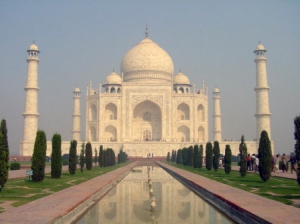AGRA AND THE TAJ MAHAL
Good road and rail links from Delhi and can be visited on a day trip from Delhi. This is not one of India’s most attractive cities. It is rather dirty and full of touts, however there are initiatives to clean it up. Streets around the Taj Mahal have been closed to petrol fueled vehicles to protect the monument from pollution. Visitors are ferried from the car park in battery powered buses. However, it is home to one of the most beautiful and romantic buildings in the world.
Places of Interest:
TAJ MAHAL
 It is best viewed at dawn or dusk, although morning fog can take time to clear during the winter months. It is recommended to take an official guide to explain the history. Shah Jahan’s monument to his favourite wife is rightly on most visitors “must see” list on a Golden Triangle tour and has always lived up to expectations for me. Viewing is also recommended from across the Yamuna River at the Mehtab Gardens. There is now strict security on entry and no sharp objects, tobacco or alcohol are permitted. It is possible to visit on the night of a full moon and 2 days on either side. Closed Fridays.
It is best viewed at dawn or dusk, although morning fog can take time to clear during the winter months. It is recommended to take an official guide to explain the history. Shah Jahan’s monument to his favourite wife is rightly on most visitors “must see” list on a Golden Triangle tour and has always lived up to expectations for me. Viewing is also recommended from across the Yamuna River at the Mehtab Gardens. There is now strict security on entry and no sharp objects, tobacco or alcohol are permitted. It is possible to visit on the night of a full moon and 2 days on either side. Closed Fridays.
AGRA FORT
Built by Emperor Akbar in 1565-1573 it is an impressive red sandstone fortress fronting the River Yamuna. It is a huge complex of halls and courtyards with airy pavilions and there is a tower called Musamman Burj with clear views of the Taj Mahal across the river. This is where Shah Jahan spent his last years, imprisoned by his son Aurangzeb and gazing at his tomb of love. The Diwan-i-Aam is the hall in which the famous Peacock Throne was found.
ITMAD-UD-DAULAH’S TOMB
Affectionately known as the “Baby Taj” it is the precursor, and perhaps inspiration of, its more famous neighbour 3 miles away. Empress Nur Jahan built this small tomb for her Father. It uses brown and yellow marble from Persia and is the earliest use of Persian style marble inlay in India, later used by Shah Jahan. It is tranquil and has beautiful gardens, a perfect spot to relax amid the buzz of Agra.
SIKANDRA
It lies 5 miles outside Agra and is the resting place of one of India’s greatest Kings, Akbar. It is widely believed Akbar designed and started the construction of his own mausoleum which his son Jahangir completed.
This holy town is 42 miles north of Agra on the banks of the Yamuna. Believed by devout Hindus to be the place where the young Lord Krishna once lived as a humble cow herd. It is a fascinating place to enter the temples (remove shoes) and listen to his name being continuously chanted. A very calm place and a genuinely happy atmosphere with plenty of clapping to get involved in.
AGRA BEAR SANCTUARY
This is a rescue centre for “dancing bears.” Although this activity was banned years ago there were still bears seen on the road between Agra and Bharatpur “dancing” for tourists. Special permission is required to visit the centre and learn about the rehabilitation of these cute bears. It is a very interesting and educational trip.
FATEHPUR SIKRI
It was built by Emperor Akbar in 1571 and was the Mughal capital for 14 years. It is a classic example of a walled city and is a mixture of Hindu and Muslim architecture. The city was abandoned, legend has it, due to a water shortage but the sturdy red sandstone buildings remain, initially preserved by Lord Curzon the Viceroy of India (1899-1905.) It is said that Akbar built the city as a celebration of the birth of his first son and heir Salim (later Jahangir.) It is a fascinating place to spend a couple of hours. At sunset the ghost city seems to glow and it is easy to imagine court life. Beautifully preserved and well worth a visit.







